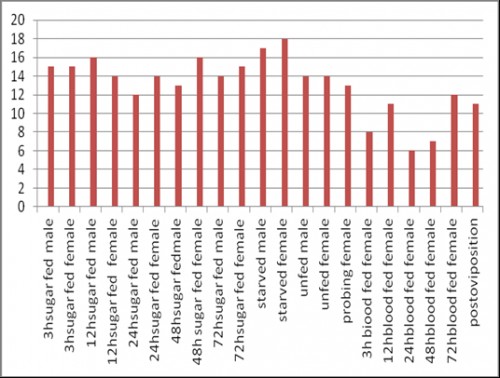Variations in protein banding patterns of salivary glands during feeding behavior of adult Culex pipiens pipiens (Diptera: Culicidae)
Author(s): AlaaEddeen M Seufi, Ismail EI and Soad A El-kenawi
Abstract: The saliva of hematophagous insects contains a variety of pharmacologically active substances that counteract the normal haemostatic response to injury in vertebrate hosts. In the present study, protein banding pattern (Native and SDS-PAGE) of salivary glands of adult Culex pipiens at sugar-fed, un-fed, starved and blood fed stages were investigated. Males and females of Cx. pipiens were dissected and their salivary glands were collected at 3, 12 and 24, 48, 72 h after sugar feeding, starved and un-fed stages. Female salivary glands were additionally collected at different stages of blood feeding; skin exploring time, 3, 12, 24, 48 and 72 h after blood meal and after oviposition. Results of native-PAGE from four different meals demonstrated that there were differences in the overall protein banding pattern in salivary glands of males and females of Cx pipiens. Results of SDS-PAGE clarified that the molecular weight of the separated proteins (in all stages) ranged from 205.13 to 10.47 KDa indicating that banding patterns differ from stage to stage. Interestingly, protein of 30 kDa was predominantly expressed in the female, but not observed in the male. In addition, 20 KDa protein was observed in starved female and the band intensity was higher in the case of sugar-fed female, but not in blood-fed females. Such finding revealed that this protein depleted after blood feeding, especially, at skin exploring time. Differences in the salivary protein’s profile may be related to the function of salivary gland and the nature of food. In conclusion, better knowledge of the molecules synthesized in saliva and the salivary gland of mosquitoes as hematophagous insects could be of use for improving the control of pathogen transmission. Today, many salivary molecules have been identified and characterized as new targets to the development of future vaccines.
 Fig.:
Fig.: Number of protein bands generated by the SDS-PAGE in sugar-fed, starved, un-fed males and females, skin exploring, blood-fed and post-oviposition for female only.
How to cite this article:
AlaaEddeen M Seufi, Ismail EI, Soad A El-kenawi. Variations in protein banding patterns of salivary glands during feeding behavior of adult Culex pipiens pipiens (Diptera: Culicidae). Int J Mosq Res 2017;4(6):33-41.



